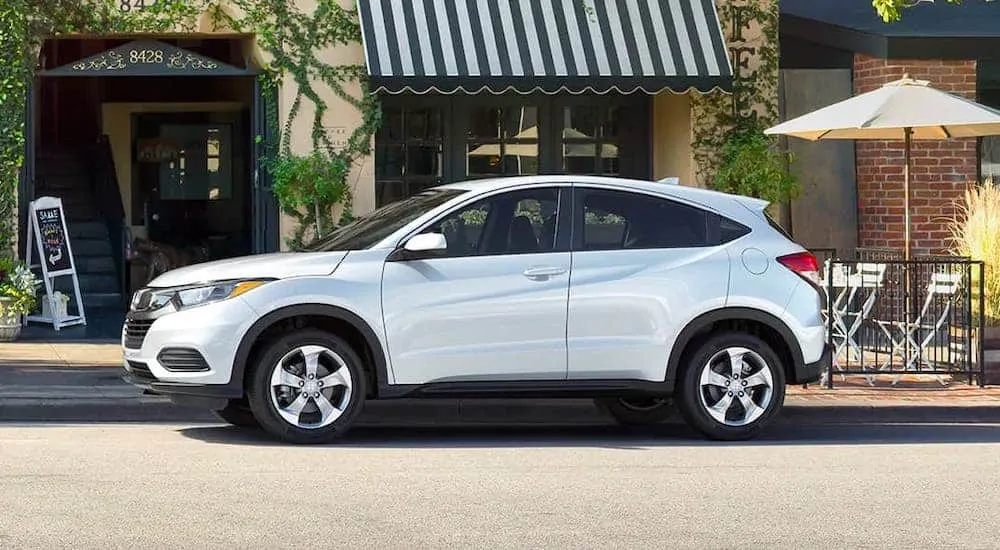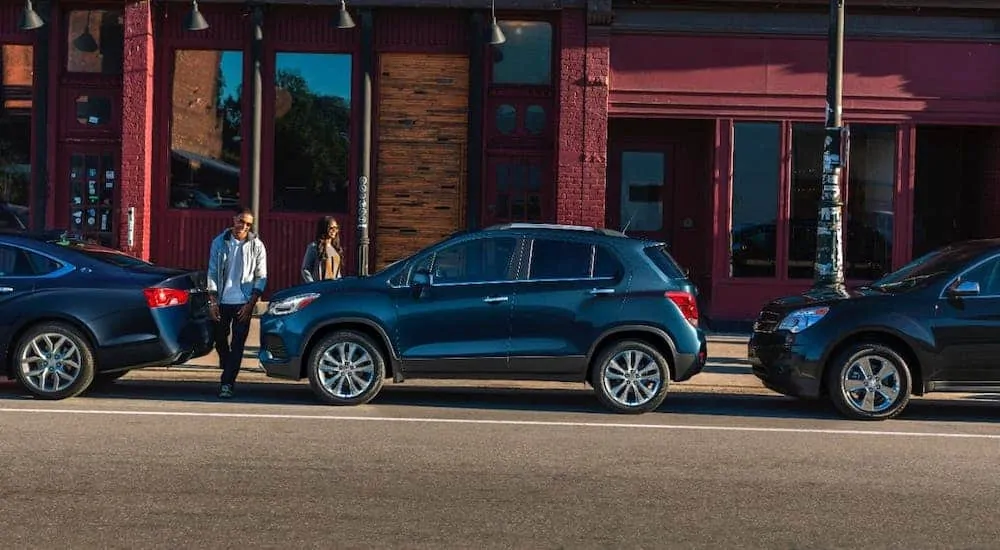Compact SUVs have an important presence in the automotive industry as their popularity continues to rise amongst fans and enthusiasts alike. When you’re looking for a vehicle with multiple uses, Compact SUVs are the perfect choice due to being constructed with versatility in mind. Many manufacturers often integrate a host of features into their SUVs, including safety, performance, connectivity, and a spacious interior to boot. Every year, many fan-favorite SUVs get an annual refresh, and competition gets a fresh renewal. One competition, in particular, has drivers picking sides between the 2020 Chevy Trax vs 2020 Honda HR-V as both vehicles sport large fan bases. Both the Trax and HR-V have many similarities, including price, seating five passengers, and they both share a common goal of being your SUV of choice. Aside from similarities, these two SUVs differentiate from one another in interesting ways.
Starting with the available trims for each vehicle, the 2020 Trax offers three available trims while the HR-V offers five. The three trims for the 2020 Trax include the LS, LT, and Premier with the base LS trim starting at an MSRP of $22,295. The five available trims for the HR-V start with the base LX trim starting at $20,920, promptly followed by Sport, EX, EX-L, and Touring. Taking the base trims for each into consideration, the MSRP of the Trax is minimally higher than the HR-V. The difference is nominal and isn’t substantial enough of a price increase to turn potential customers away from the Trax.
How Do The Engines Compare?
Both the 2020 Trax and HR-V have 4-cylinder, however, the Trax’s engine is the smaller of the two due to being turbocharged. The engine found inside of the Trax is a 1.4L 4-Cyl, while the HR-V’s engine is a 1.8L 4-Cyl. Thanks to the turbocharged nature of the Trax’s engine, it’s able to produce 138 hp and 148 lb-ft of torque regardless of its smaller nature. The non-turbocharged 1.8L 4-cyl found in the HR-V in comparison gets 141 hp and 127 lb-ft of torque. This ultimately means this engine only produces 2% more horsepower than the smaller engine seen in the Trax. Additionally, it’s impressive considering this smaller 1.4L 4-Cyl also produces 16% more torque than the HR-V’s engine. The Trax and HR-V both provide ample fuel efficiency ratings that aren’t too dissimilar from each other. Looking at the FWD models for each vehicle, the Trax gets EPA-estimated ratings of 26 MPG city and 31 highway. In comparison, the HR-V gets ratings of 28 MPG city and 34 highway, which are slightly better than the Trax, but only by 7% and 9% respectively.

Connectivity & Entertainment Features
SUVs are commonly known as vehicles that are well suited for long road trips. Anybody looking for a new vehicle with events such as family vacations in mind should certainly consider an SUV. Thanks to the integrations of many modern tech-centric feature sets, the days of “Are we there yet?” have finally come to a close. A significant piece of tech that has been continuously increasing in popularity is the infotainment system. Simply put, infotainment systems have revolutionized how we stay connected while our phones are inaccessible on the road. No longer do you have to grab your phone to change a song or even answer a phone call; the infotainment center does it all. Only one of these vehicles comes standard with an infotainment center, however.
Infotainment centers aren’t always guaranteed with a vehicle, especially for the base trims. Not only does the Trax come standard with a 7-inch touch screen, but it also comes standard with a 4G LTE Wi-Fi hotspot. Comparing this to the HR-V, the Wi-Fi hotspot is only reserved for the highest-tier trim, and the base model comes with a five-inch screen. Those looking to match the 7-inch screen seen in the Trax for their HR-V will have to pay extra to upgrade it. Additionally, those looking to utilize Apple CarPlay and Android Auto will have to pay for the upgraded infotainment center in the HR-V while it comes standard on the base Trax. Drivers who have never experienced owning a vehicle with CarPlay and Auto should certainly consider buying a vehicle with these included. One of the primary reasons as to why CarPlay and Auto have found a substantial amount of success in recent years is because of their seamless integration with devices many drivers already own. The devices that work with CarPlay are the iPhone 5 and up, and Android Auto works with a wide range of compatible Android devices.
With Apple CarPlay and Android Auto, your infotainment center is granted a whole new layer of accessibility by utilizing the functions of your smartphone. For example, if you need to answer a phone call or even make one, you can do this with the infotainment center rather than your phone. The same goes for text messaging. This is made even easier with full access to your smartphone’s virtual assistant, such as Siri or Google Assistant. You’ll also be able to select from your favorite music playlists and other forms of media to your vehicle’s speakers for entertainment on the road. Navigation is made much easier when connecting to CarPlay or Auto as you can utilize Apple or Google maps for turn-by-turn navigation on the infotainment screen itself. Should you want any additional useful features, both CarPlay and Auto feature app stores provided by Apple and Google. From these app stores, you’ll be treated to a wide list of helpful apps that you may download and utilize in a matter of seconds.
Safety Features
The 2020 Trax and HR-V both come standard with a rear-view camera that is displayed onto your infotainment center screen. Chevy and Honda do allow users to add a host of available safety upgrades. Owners of the Trax or HR-V may opt for features such as rear cross-traffic alert. This is a safety system that will send out visual or auditory signals if it detects an imminent collision with an oncoming vehicle when reversing out of a parking space, for example. Blind-spot monitoring is another feature that may be added to either the Trax or HR-V, and as the name implies, it monitors your vehicle’s blind-spots and will notify you if a vehicle is approaching.
Forward collision warning is also an available upgrade that can calculate the speed of your vehicle with the driver in front of you and will use this data to warn you of an impending impact should you get too close. Lane departure warning is available for the two vehicles, a feature that sends out alerts to the driver if it detects the vehicle is unintentionally crossing a lane. The HR-V does allow for some extra safety features that are unfortunately omitted from the Trax such as adaptive cruise control, automatic high-beam headlights, and automatic emergency braking to name a few. Overall, both vehicles provide a respectable amount of available safety features, and the standard rear-view camera is appreciated.
The Consensus
It’s no secret the automotive industry is continuously bustling, and innovation never comes to a halt. There’s a lot to like with both of these SUVs, but when it comes to the best overall package, the 2020 Chevy Trax is the better option. With a highly similar price range and performance output, the real difference-maker comes down to integrated software. Those who purchase the base Trax are going to be very satisfied with their purchase, whereas HR-V customers are likely to notice the omission of a proper infotainment center. Those looking to purchase an SUV for their versatility and utilize them in their everyday lives, you’ll be appealed by the idea of having CarPlay and Auto come standard. Although both vehicles display a strong level of competition, the Trax gets the edge for the overall experience instead of just one area.





